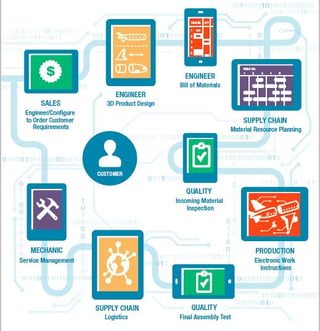 LNS Research has seen a lot of interest in the benefits of the Industrial Internet of Things (IIoT) as our research survey indicates. The extent of benefits vary on what companies expect to see from the IIoT. Not unexpectedly, there are some significant differences between the greatest value that manufacturers of discrete products expect to see versus batch and process manufacturers.
LNS Research has seen a lot of interest in the benefits of the Industrial Internet of Things (IIoT) as our research survey indicates. The extent of benefits vary on what companies expect to see from the IIoT. Not unexpectedly, there are some significant differences between the greatest value that manufacturers of discrete products expect to see versus batch and process manufacturers.
Click here to speak with Dan
Discrete device manufacturers foresee a future where the products they make will be smart and reside on the IIoT while process manufacturers, such as oil refineries, do not envision “smart gasoline” anytime in the future. Process manufacturers, particularly resource processing industries, see the benefit of the IIoT more in asset health and a more efficient supply chain. Given almost half of the early respondents to our IIoT survey have indicated they do not have any plans to deploy smart devices, it seems these companies need better arguments as to why they need to make the move to Smart Connected Assets/Devices enabled by the IIoT.
1. You Can’t Make Next Generation Products in Last Century Plants
In the previous steps of evolution in manufacturing, as we moved from the single craftsman to the assembly line to the automated factory, the driving factors were not just about efficiency. Assembly lines came driven by the emergence of standardized and interchangeable parts as much as by the desire to increase productivity. You could not have one without the other. Likewise, the computerization of the plant was driven as much by the need to produce higher precision devices as it was to increase volume and lower labor costs. Without the repeatability of automated systems, the ability to produce the highly automated devices themselves would have been uneconomical.
As we move to Industrie 4.0/Smart Manufacturing, the next evolution, the same holds true. You cannot make smart devices in a dumb plant, at least not efficiently and economically. Smart devices inherently have the complexity of embedded code. within. It will require the ability to ensure that products shipped have the most recent version. In other cases, it will require the ability to ensure the differences between variants of a product that will be solely a function of the software embedded within. In either case the technology to manufacture these devices will need to be as smart or smarter than the devices being manufactured.
2. Increasing Emphasis on Compliance and Efficiency Demands Smarter Plants
Whether you are a discrete, batch, or process manufacturer the reality today is that the regulatory burden, particularly as it relates to sustainability issues such as carbon footprint, recycling and safety is only going to increase. In the face of this regulatory pressure, the simple business truth is that doing more with less has become the norm. Today’s automobiles are complex smart devices with extensive embedded IIoT technology, which is one reason they are safer and more fuel-efficient than ever. Trying to operate a plant built in the 60s’ or 70s’ is like trying to get 35 mpg and a four-star crash rating from a 1970 sedan – it isn’t going to happen. Regardless of what type of manufacturing operation your enterprise operates, operational excellence can not be achieved, going forward, without embracing a digital transformation of your business.
As we have said many times before, healthy assets are the foundation of a healthy business. Condition-based maintenance (CBM) is doable today without using IIoT technology, but it is more difficult and not as affordable, hence not capable of being deployed broadly. It is like trying to build a house using only hand tools, doable but outrageously expensive, time consuming and far more difficult to do from a quality perspective. Power tools enable the building of affordable, quality housing in quantity. Running factories today requires that same commitment and IIoT Smart Connected Assets are the power tools of modern manufacturing.
NEW Research Spotlight on strategies and recommendations for minimizing risk through a migration away from monolithic, single-plant MOM architectures through exploration of Cloud and IIoT technologies that are advancing in manufacturing today.